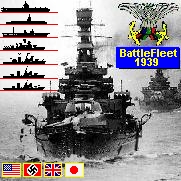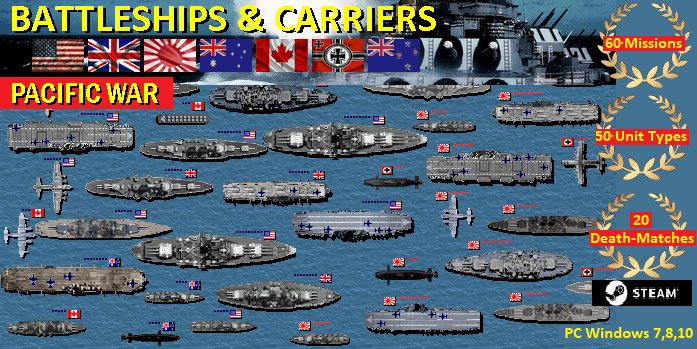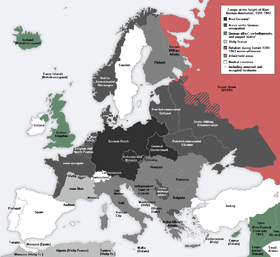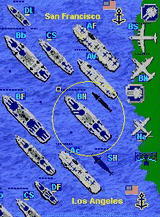List of
German Navy Ships WW2
Battleship Bismarck,
Graf
Zeppelin
Battleships Tirpitz,
Scharnhorst Admiral
Graf Spee U-Boats
Types 1, 2A, 2B, 2C, 2D
Kriegsmarine
Submarines Types U-Flak, 7A, 7B, 7C,
7C/41, 7C/42, 7D, 7F Kriegsmarine
Submarines: U-Boats Type 9A,
9B, 9C, 9C/40, 9D, 14
Submarines: Type
XXI , Type XXIII
Grand Admiral Karl
Donitz, Erich RaederHMS Prince
of Wales Battleship, HMS Repulse HMS Ark
Royal, HMS Hood
Battlecruisers Battle of
Crete - Operation Mercury
WW2 Battle
of Taranto
Battle of
Cape Matapan Battle of
Narvik Battle of the River
Plate,
Battle of Dunkirk,
Battle of the Atlantic
Battleship Game - WW2
Naval Strategy: No1 Battleship Game for PC and No3 Aircraft Carrier Game on World Net
Missions and Scenarios:
Pearl Harbor Game
Atlantic Game 1943
Sink Cruisers Game
Midway Game
Iwo Jima Game
US Marines Game
Luftwaffe Game Pacific
Torpedo Game Boats
Bismarck Game Pacific
Destroy RAF Game
Okinawa
Us Navy Submarine Game
Fleet Submarines Game
Kamikaze Game
U Boat Game
Singapore Game
Swordfish Hunt
Patrol Boats
Air Supremacy
Alert
Battleships Game
Java
Defense
Fleet Cruisers Game
Atlantic Island
Coral Sea Game
Iron Sea
Mykonos
Imperial Ocean
Long Convoy
Skagerrak
Target Los Angeles
West Pacific Game
Pacific War Game
Leyte Transport
Emperor Hirohito
Normandy Game
South Pacific Game
Destroy USAF Game
Submarine Games
US Navy Game
Free Hunt Doenitz Game
Free Hunt Spruance Game
Free Hunt Halsey Game
Imperial Navy I
Royal Navy Game
Free Hunt Pearl Harbor Games
Midway II
Kriegsmarine I
Brisbane Convoy
Clear West Coast
Fall Of Australia
Battle For Leyte
Conquer Of Japan
HMAS Perth
Road To Okinawa
Orange Ports
Emperor Defense
Prince Of Wales
San Bernardino
Pacific Race
Heavy Duty
Tokio Express
Operation Sidney
Bomber Operation
Conquer Of Italy
Heavy Cruiser Game
Frigate Hunt
Santa Cruz
Lamansh Game
Azores Transport
Norway Convoy
Invasion
Grossadmiral
Norway Ports
Drang Nach Ost
Convoy Pk30
Ciano Defense
Sir John Tovey
Free Hunt Andrews
Germans On Pacific
Silent Hunt
Antigua
Return To Midway
Kriegsmarine Game II
Royal Air Force Game
F. Hunt Lancaster
Jamamoto Game
Free Hunt USN
Free Hunt Japan
Free Hunt RAAF
Free Hunt U Boat Game
Free Hunt Aircraft Carriers Game
Free Hunt Hawaii
Free Hunt Yamato Game
Free Hunt Iwo Jima Game
Free Hunt Pacific Game
Free Hunt Torpedos
Free Hunt Convoy
Free Hunt Germany
Free Hunt Germany II
Free Hunt Italy
Free Hunt Malaya
Free Hunt Subs Game
Free Hunt B-29 Game
Free Hunt USN 1944
Devil Island
Dragoon Carriers
|
Organizations
in The Third Reich
The leaders of Nazi Germany created a large number of
different organisations for the purpose of helping them
in staying in power. The character of the most of them is
typical for totalitarian regimes, although most countries
do have armed forces of some sort.
Military
Oberkommando der Wehrmacht (OKW) -- Armed Forces High
Command
Oberkommando des Heeres (OKH) -- Army High Command
Oberkommando der Marine (OKM) -- Navy High Command
Oberkommando der Luftwaffe (OKL) -- Airforce High Command
Wehrmacht -- Armed Forces
Heer -- Army
Luftwaffe -- Airforce
Kriegsmarine -- Navy
Oberbefehlshaber West
Abwehr -- Military Intelligence
Paramilitary
organisations
SA -- Sturmabteilung
SS -- Schutzstaffel
Waffen-SS
Deutscher Volkssturm
State police
- Reich Central Security Office (RSHA -
Reichssicherheitshauptamt)
- Regular Police (Ordnungspolizei (ORPO))
- Schutzpolizei (Safety Police)
- Gendarmerie (Rural Police)
- Gemeindepolizei (Local Police)
- Security Police (Sicherheitspolizei (SIPO))
- Geheime Staatspolizei (Gestapo)
- Reich Kriminalpolizei (Kripo)
- Sicherheitsdienst (SD)
Political organizations
Nazi Party -- National Socialist German
Workers Party (abbreviated NSDAP)
Youth organisations
Hitler-Jugend -- Hitler-youth (for boys
and young men)
Bund Deutscher M?del (for girls and
young women)
Labour organisations
Deutsche Arbeitsfront
Kraft durch Freude
Wehrmacht
The unified armed forces of Germany from 1935 to 1945
were called the Wehrmacht. This included the Heer (army),
Kriegsmarine (navy), and the Luftwaffe (air force). From
2 August 1934, members of the armed forces were required
to pledge an oath of unconditional obedience to Hitler
personally. In contrast to the previous oath, which
required allegiance to the constitution of the country
and its lawful establishments, this new oath required
members of the military to obey Hitler even if they were
being ordered to do something illegal. Hitler decreed
that the army would have to tolerate and even offer
logistical support to the Einsatzgruppen—the mobile
death squads responsible for millions of deaths in
Eastern Europe—when it was tactically possible to do
so.Members of the Wehrmacht also participated directly in
the Holocaust by shooting civilians or undertaking
genocide under the guise of anti-partisan operations.
In spite of efforts to prepare the country militarily,
the economy could not sustain a lengthy war of attrition
such as had occurred in World War I. A strategy was
developed based on the tactic of Blitzkrieg (lightning
war), which involved using quick coordinated assaults
that avoided enemy strong points. Attacks began with
artillery bombardment, followed by bombing and strafing
runs. Next the tanks would attack and finally the
infantry would move in to secure any ground that had been
taken.Victories continued through mid-1940, but the
failure to defeat Britain was the first major turning
point in the war. The decision to attack the Soviet Union
and the decisive defeat at Stalingrad led to the retreat
of the German armies and the eventual loss of the war.
The total number of soldiers who served in the Wehrmacht
from 1935 to 1945 was around 18.2 million, of whom 5.3
million died.
SA and SS
Sturmabteilung (SA; Storm Detachment; Brownshirts),
founded in 1921, was the first paramilitary wing of the
Nazi Party. Their initial assignment was to protect Nazi
leaders at rallies and assemblies.[197] They also took
part in street battles against the forces of rival
political parties and violent actions against Jews and
others.By 1934, under Ernst R?hm's leadership, the SA had
grown to over half a million members—4.5 million
including reserves—at a time when the regular army
was still limited to 100,000 men by the Versailles
Treaty.
Rohm hoped to assume command of the army and absorb it
into the ranks of the SA.[200] Hindenburg and Defence
Minister Werner von Blomberg threatened to impose martial
law if the alarming activities of the SA were not
curtailed.[201] Hitler also suspected that R?hm was
plotting to depose him, so he ordered the deaths of R?hm
and other political enemies. Up to 200 people were killed
from 30 June to 2 July 1934 in an event that became known
as the Night of the Long Knives.[202] After this purge
the SA was no longer a major force.
Initially a force of a dozen men under the auspices of
the SA, the Schutzstaffel (SS) grew to become one of the
largest and most powerful groups in Nazi Germany.Led by
Reichsf?hrer-SS Heinrich Himmler from 1929, the SS had
over a quarter million members by 1938 and continued to
grow.Himmler envisioned the SS as being an elite group of
guards, Hitler's last line of defence.The Waffen-SS, the
military branch of the SS, became a de facto fourth
branch of the Wehrmacht.
In 1931 Himmler organised an SS intelligence service
which became known as the Sicherheitsdienst (SD; Security
Service) under his deputy, SS-Obergruppenf?hrer Reinhard
Heydrich.This organisation was tasked with locating and
arresting communists and other political opponents.
Himmler hoped it would eventually totally replace the
existing police system.Himmler also established the
beginnings of a parallel economy under the auspices of
the SS Economy and Administration Head Office. This
holding company owned housing corporations, factories,
and publishing houses.
From 1935 forward the SS was heavily involved in the
persecution of Jews, who were rounded up into ghettos and
concentration camps.With the outbreak of World War II, SS
units called Einsatzgruppen followed the army into Poland
and the Soviet Union, where from 1941 and 1945 they
killed more than two million people, including 1.3
million Jews. SS-Totenkopfverb?nde (death's head units)
were in charge of the concentration camps and
extermination camps, where millions more were killed.
NSDAP Nazi Party leaders and
officials:
Gunter
d'Alquen
Ludolf von Alvensleben
Max Amann
Benno von Arent
Heinz Auerswald
Hans Aumeier
Arthur Axmann
Erich von dem Bach
Herbert Backe
Richard Baer
Alfred Baeumler
Gottlob Berger
Werner Best
Hans Biebow
Gottfried Graf von Bismarck-Sch?nhausen
Paul Blobel
Werner von Blomberg
Hans-Friedrich Blunck
Josef Bl?sche
Horst B?hme
Ernst Boepple
Ernst Wilhelm Bohle
Martin Bormann
Philipp Bouhler
Viktor Brack
Karl Brandt
Alois Brunner
Walter Buch
Karl Buck
Josef B?rckel
Anton Burger
Werner Catel
Heinrich Cla?
Carl Clauberg
Leonardo Conti
Kurt Daluege
Richard Walther Darr?
Joseph "Sepp" Dietrich
Otto Dietrich
Oskar Dirlewanger
Horst Dressler-Andress
Irmfried Eberl
Adolf Eichmann
Theodor Eicke
August Eigruber
Hermann Esser
Richard Euringer
Karl Fiehler
Ludwig Fischer
Albert Forster
Hans Frank
Karl Hermann Frank
Roland Freisler
Wilhelm Frick
Hans Fritzsche
Walther Funk
Karl Gebhardt
Achim Gercke
Kurt Gerstein
Odilo Globocnik
Richard Gl?cks
Joseph Goebbels
Wilhelm Gocke
Hermann Goring
Amon G?th
Ulrich Greifelt
Robert Ritter von Greim
Arthur Greiser
Wilhelm Grimm
Walter Gro?
Kurt Gruber
Hans G?nther
Franz G?rtner
Eugen Hadamovsky
Ernst Hanfstaengel
Karl Hanke
Fritz Hartjenstein
Paul Hausser
Franz Hayler
Heinrich Heim
August Hei?meyer
Otto Herzog
Rudolf He?
Walther Hewel
Werner Heyde
Reinhard Heydrich
Konstantin Hierl
Erich Hilgenfeldt
Heinrich Himmler
Hans Hinkel
August Hirt
Adolf Hitler
Hermann H?fle
Rudolf H??
Franz Hofer
Karl Holz
Karl J?ger
Ernst Jarosch
Friedrich Jeckeln
Alfred Jodl
Hanns Johst
Hans J?ttner
Rudolf Jung
Ernst Kaltenbrunner
Karoly Kampmann
Karl Kaufmann
Wilhelm Keitel
Wilhelm Keppler
Hanns Kerrl
Dietrich Klagges
Wilhelm Kleinmann
Helmut Knochen
Erich Koch
Ilse Koch
Karl Otto Koch
Max K?gel
Franz Konrad
Wilhelm Koppe
Josef Kramer
Fritz Krebs
Bernhard Kr?ger
Friedrich Wilhelm Kr?ger
Gustav Krupp
Hans Lammers
|
Herbert
Lange
Adolf Lenk
Robert Ley
Arthur Liebehenschel
Julius Lippert
Michael Lippert
Dietrich Loder
Wilhelm Loeper
Georg L?rner
Hinrich Lohse
Werner von Lorenz
Hanns Ludin
Martin Luther
Viktor Lutze
Emile Maurice
Kurt Mayer
Herbert Mehlborn
Josef Mengele
Alfred Meyer
Konrad Meyer
Kurt Meyer
Heinrich M?ller
Eugen M?ndler
Alfred Helmut Naujoks
Arthur Nebe
Hermann Neef
Karl Neuhaus
Konstantin Freiherr von Neurath
Herta Oberheuser
Otto Ohlendorf
Helmuth von Pannwitz
Otto Paul
Joachim Peiper
Salomon Franz von Pfeffer
Henry Picker
Paul Pleiger
Oswald Pohl
Franz von Pfeffer
Erich Priebke
Hans-Adolf Pr?tzmann
Karl Rahm
Rudolf Rahn
Friedrich Rainer
Erich Rajakowitsch
Sigmund Rascher
Walther Rauff
Hermann Rauschning
Hanns Rauter
Walter Reder
Wilhelm Reinhard
Fritz Reinhardt
Adrian von Renteln
Joachim von Ribbentrop
Rolf Rienhardt
Ernst R?hm
Erwin R?sener
Alfred Rosenberg
Wilhelm Ruder
Ernst Rudin
Bernhard Rust
Fritz Sauckel
Hjalmar Schacht
Emanuel Schaefer
Gustav Adolf Scheel
Walter Schellenberg
Hans Schemm
Wilhelm Schepmann
Baldur von Schirach
Franz Schlegelberger
Albrecht Schmelt
Carl Schmitt
Kurt Schmitt
Paul Schmitthenner
Gertrud Scholtz-Klink
Kurt Freiherr von Schr?der
Walther Schultze
Arthur Sch?rmann
Franz Xaver Schwarz
Heinrich Schwarz
Siegfried Seidl
Franz Seldte
Arthur Sey?-Inquart
Gustav Simon
Albert Speer
Walter Stang
Franz Stangl
Johannes Stark
Otto Steinbrink
Gregor Stra?er
Otto Stra?er
Julius Streicher
J?rgen Stroop
Otto von St?lpnagel
Friedrich Syrup
Josef Terboven
Otto Thierack
Fritz Todt
Hans Trummler
Hans von Tschammer und Osten
Xavier Vallat
Albert V?gler
Hermann Vo?
Hilmar W?ckerle
Otto Wagener
Adolf Wagner
Gerhard Wagner
Josef Wagner
Robert Wagner
Christian Weber
Wilhelm Wei?
Horst Wessel
Robert Wetzel
Max Winkler
Giselher Wirsing
Christian Wirth
Hermann Wirth
Karl Wolff
Adolf Ziegler
Matthes Ziegler
Wilhelm Ziegler
Hans Z?berlein
Franz Ziereis |
| CIA / KGB Operation
Game. Run your own intelligence game.
Travel around the world and set up espionage
game, trade with state secrets, weapon systems,
spy codes, WMD, hire secretaries, agents, lawyers
and soldiers, establish secret agent stations,
cells and bases and search for criminals and
politicians. Involve in agent game. Game contains
more than 40 missions including Nuclear Game,
Cold War Game, Secret Agent, CIA Games, USAF,
Prime Minister, RAF, Bin Laden, Sadam, KGB,
Operations Iran… |
|
|
| |
 |
 |
| Turn-based WW2
naval game, extension to the classic
Submarine game (Battleship game) where
ships/planes/subs can move. Contains plenty of
game missions, game campaigns and 40 ship,
submarine, airplane ana port artillery types,
with combat maps up to 96X96 large. |
| |
| |
| |
| |
|
| Tycoon Strategy
Game - build your own world business empire as an
arms dealer tycoon. Travel around the world,
trade with more than 400 weapon systems, hire
secretaries, bodyguards, lawyers, fighters and
tanks, establish companies and search for
criminals and hostages. |
| |
The
Reichskommissariat (Reich Commissariat) is the German
designation for a type of administrative office headed by
a government official known as a Reichskommissar
(English: Reich Commissioner). Although many different
such offices existed primarily throughout the Imperial
German and Nazi periods in a number of different fields
(such as public infrastructure, spatial planning, ethnic
cleansing, etc.) it is most commonly used to refer to the
quasi-colonial territorial units established by Nazi
Germany in several occupied countries during World War
II. While officially located outside of the German Reich
in a legal sense, these entities were directly controlled
by their supreme civil authorities (the
Reichskommissars), who ruled their assigned territories
as German governors on behalf of and as direct
representatives of Adolf Hitler.
The introduction of these territorial administrations
served a number of purposes. Those established or planned
to be established in Western and Northern Europe were in
general envisioned as the transitional phases for the
future incorporation of various Germanic countries
outside of pre-war Germany into an expanded Nazi state.
Their eastern counterparts served primarily colonialist
and imperialist purposes, as sources of future Lebensraum
for German settlement and the exploitation of natural
resources.
Another contrast was the level of administrative overhaul
implemented in these two types. As in most other
territories conquered by the Germans, local
administrators and bureaucrats were pressured to continue
their regular day-to-day operations (especially at the
middle and lower levels) albeit under German oversight.
Throughout the war the Reichskommissariats in Western and
Northern Europe simply retained the previously existing
administrative structure however, while in the eastern
ones completely new such structures were introduced.
All of these entities were nonetheless intended for
eventual integration into a Greater Germanic Reich
(Grossgermanisches Reich) encompassing the general area
of Europe stretching from the North Sea to the Ural
mountains, for which Germany was to form the basis
|




